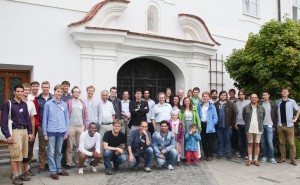The great cathedrals of medieval Europe are often cited as the physical monuments to an Age of Faith; similarly, the mammoth particle accelerators of our day are sometimes said to be the parallel physical manifestations of our Age of Science. It is particularly appropriate therefore that this year’s Linear Collider School was held in the Abbey of Frauenwörth. The abbey takes up a significant fraction of the area of the small island of Frauenchiemsee in the Chiemsee, a lake formed in southern Bavaria at the end of the last Ice Age. The abbey, which was founded by Duke Tassilo III of Bavaria in 772, is one of the oldest in Germany. This beautiful island, framed to the south by the beginnings of the Alps, played host last week to around 25 students and 19 lecturers who discussed the latest ideas and news on linear colliders and their place in our developing picture of particle physics.
The Linear Collider School is the latest in a series that for many years was held in North-West England, in another famous beauty spot, the Lake District. The guiding spirit of the school, Gudrid Mortgat-Pick, now at the University of Hamburg, was for many years a faculty member at the University of Durham, only about 100 kilometres east from the Lake District. Gudi, who is a native of Bavaria, had the idea to continue the Linear Collider School in her home state in similar surroundings and came upon the happy idea of basing it in one of the most famous beauty spots in Germany, Chiemsee. The old monastic buildings, crowned by an “onion” dome typical of Bavarian and Austrian church architecture, are large and magnificent. Although these buildings host a community of Benedictine nuns, there is ample space to let out bedrooms and meeting rooms to appropriate conferences. The bedrooms are completely unlike the monastic cells that the buildings originally contained; large and comfortable, they look out either onto the lake and the Alps or into a quiet interior courtyard. The peace of the setting is palpable and the venue offers an excellent place for both students and lecturers to concentrate on the latest developments in physics, detectors and accelerators related to linear colliders.
The school began on Monday afternoon with some general introductory lectures. Filip Moortgat of CERN gave a masterly overview of LHC physics, commenting on what LHC would be able to achieve in future running and what must be left for the ILC. I introduced the two linear collider machines, the ILC and CLIC, and described the various component parts of any linear collider while highlighting the differences between CLIC and the ILC. I concluded with the latest political developments and the possibility of Japan hosting the ILC. François Richard from Orsay looked back to the experience at LEP and drew lessons for the future; perhaps most importantly the difficulty of increasing the energy of a circular machine once the tunnel was constructed. This not only led to LEP just missing the discovery of the Higgs but also previously in the 1970s had led to the ADONE collider at Frascati just missing the discovery of the J/psi. The evening ended with more research; a trip to the island’s brewery, which makes beer not only according to the traditional German “Reinheitsgebot”, or purity law, but also uses only organic natural products. It was clear that several of our students began to think about switching fields when the Master Brewer told us that it was possible to obtain a doctorate in Beer Brewing!
On the following day the detailed work of the school began, covering the whole range of topics that can be explored at linear colliders with both theoretical and experimental lectures. It was clear even from the sessions on Tuesday morning that linear colliders have a vital and extremely interesting programme of physics under any scenario of what the LHC might achieve in the next decades. Lecturers not only covered physics, but also accelerator topics, with Eckhard Elsen building on my introduction to cover the machine physics underlying linear colliders. Karsten Büßer discussed the detailed problems at the ILC of ensuring that the accelerator and detectors fit together in time and space in the optimal way to minimise interference and maximise physics reach. The unusually inclement weather meant that plans to spend the Wednesday afternoon excursion up a neighbouring mountain had to be cancelled in favour of an exploration of the much larger neighbouring island, Heerenchiemsee. This is famous for its remarkable palace, built by the famous “Mad King” Ludwig II. As pointed out by François Richard, its hall of mirrors emulates that of the palace of Versailles. The fact that the palace remained incomplete after the King’s death is a reminder that we need to start – and finish – the ILC soon!
Even half-way through the school, as I write, it is clear that it has been a great success. The peaceful surroundings were very conducive to concentration and discussion of physics while the nearby inns provided the possibility of continuing the discussions in convivial surroundings. Members of the organising committee will analyse the effectiveness of the conference and its future but it is already clear that the school has found a very suitable new home. It is hoped that the Linear Collider School will be held again in Chiemsee in the summer of 2016. I, for one, am hoping to receive an invitation to return and hope that many more students, and lecturers, will join us.



Recent Comments